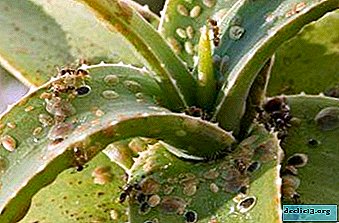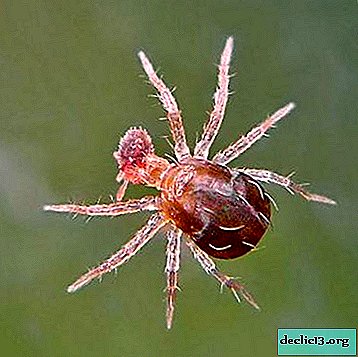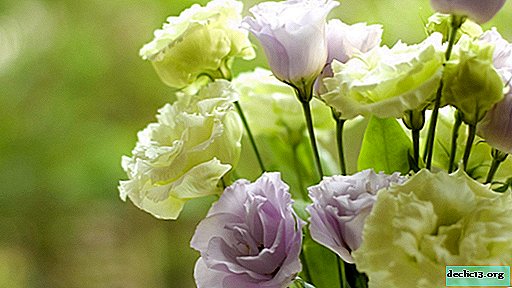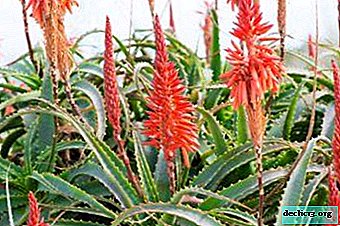All possible aloe diseases and ways to combat them
 Aloe is a plant that to a greater extent does not bring aesthetic pleasure, but benefits the human body, as it has healing properties. It is often used in medicine and cosmetology. Aloe also helps many at home.
Aloe is a plant that to a greater extent does not bring aesthetic pleasure, but benefits the human body, as it has healing properties. It is often used in medicine and cosmetology. Aloe also helps many at home.
But even this flower itself can have diseases that are caused by improper care or pest attacks. To know what to deal with, you need to look for reasons. About all ailments - in the article in order.
Problems with leaves and their treatment at home
Yellowing
There can be many reasons for yellowing. Mainly:
- improper size of the flower pot - most likely the plant has nowhere to develop;
- increased air temperature;
- sunburn (especially when drops of water remain on the leaf plates after watering);
- there are not enough nutrients in the soil, or vice versa, top dressing does not fit aloe;
- for a long time the flower did not change the "place of residence";
- improper irrigation regime - the soil should not be dry or very wet, but only slightly moistened;
- draft;
- the plant was frozen;
- damaged root system.
About why aloe leaves turn yellow and what to do about it, we described in detail in this material.
You can find out why the ends of leaves turn yellow on aloe and how to deal with it, from the video:
Drying
 Drying occurs for one reason: a flower has not been transplanted for a long time. In the old flowerpot for him there is already too little space, the roots have nowhere to develop.
Drying occurs for one reason: a flower has not been transplanted for a long time. In the old flowerpot for him there is already too little space, the roots have nowhere to develop.
In addition, the soil is already too depleted: there are no nutrients in it. Therefore, the plant begins to feed on itself, starting with leaves.
Sometimes leaf plates can dry out due to old age. But this applies only to the lower leaves and plants, whose age exceeds five years.
You will learn about why aloe dries and how to save the plant from this article.
Falling
This can happen due to wetting the soil with cold water. Water for irrigation must be defended and wait until she gets room temperature. By and large, such an aloe reaction can occur to any sudden changes in care, so you should try not to do this.
Soft leaf blades
Do not worry if only the lower foliage becomes soft. If at the same time the upper leaves are green and elastic, there is nothing to fear.But in other cases, you need to find the cause of this disease of aloe foliage. There may be three.
- Waterlogging of the soil, because of which rhizomes often rot.
- This can also happen from a lack of water in the soil.
- The last reason for the loss of turgor leaves may be frostbite.
In more detail about problems with aloe leaves, as well as about the features of plant care, we wrote in this article.
Indoor plant diseases: how they look in the photo, what to treat?
Why is it growing poorly?
Why is scarlet sometimes poorly developed or not growing at all?
- Unsuitable soil. If the gardener decided to prepare the soil on his own, then you need to make sure that there is a sufficient amount of peat in it. If you decide to purchase a ready-made soil mixture, then you need to choose one intended for cacti and succulents. It will not be superfluous even to add charcoal and brick chips to the purchased land.
- Do not allow the soil to dry out, but also do not bring to stagnation of water.
- Lack of trace elements. It is necessary to feed the plant with ready-made nutritional complexes every two weeks.

Dry rot
The problem with this process is that decay is absolutely imperceptible from the outside, aloe dries and rots inside. Therefore, in time to notice such a nuisance is very difficult. How to cure a plant? The only way to protect the flower from dry rot is prevention. To do this, spray the plant with antifungal drugs.

Root rot
Aloe root rot usually develops for two reasons:
- low air temperatures;
- excessive soil moisture.
It will be possible to revive the flower only at the initial stage of development of root rot. It is necessary to normalize watering and air temperature.
If such measures have not led to improvement, you need to take directly to the root system. First, remove it from the pot and remove the rotten roots. Sprinkle the remaining with crushed coal and transplant into soil with a high sand content. The first twenty days, the plant does not need to be watered.
If the rhizomes died completely, you can save the plant by propagating it by cuttings.

Withering
Often such a process occurs only due to improper watering: it is too much, because of which the rotting of the roots begins, or vice versa, the earth is too dry. Or cold water is used.
Withering occurs due to improperly selected light conditions: the light must be scattered.Aloe should be protected from direct sunlight.

How to save a succulent if it dies?
Aloe can die due to improper care. These are mistakes in watering (it is enough to water once a week), light (lighting should be average) and temperature (aloe does not like hot rooms) mode. You need to regularly inspect the plant for damage, rot, and also for pests. And in time to eliminate the arisen problems.
About the reasons why aloe dies, as well as about how to save the plant, we described in detail here.
Pests
Shield
 The shield has the ability to pierce the plant and suck out the juice from it, it can infect it with viruses, and also contributes to the development of mold and fungal diseases. The danger of scale insects lies in the fact that it can be seen only when it multiplies in large quantities.
The shield has the ability to pierce the plant and suck out the juice from it, it can infect it with viruses, and also contributes to the development of mold and fungal diseases. The danger of scale insects lies in the fact that it can be seen only when it multiplies in large quantities.
The main weapon against this pest is insecticidal drugs. Processing should be carried out several times with an interval of a week. And it’s better to start treatment immediately. For mechanical removal of the scab, you need to walk along the surface of the plant with a cotton swab dipped in vinegar.
Spider mite
 A feature of this pest is its miniature size: the largest individual barely reaches one millimeter. And the danger lies in the fact that the spider mite has the ability to easily spread over long distances and infect other plants. Therefore, when such a pest is detected, first of all, it is necessary to isolate the affected plant.
A feature of this pest is its miniature size: the largest individual barely reaches one millimeter. And the danger lies in the fact that the spider mite has the ability to easily spread over long distances and infect other plants. Therefore, when such a pest is detected, first of all, it is necessary to isolate the affected plant.
The color of infected aloe changes to yellowish gray. With an advanced stage, a light cobweb develops on the surface of the flower, which then moves the parasite. Such a plant absolutely does not develop and does not grow.
To overcome the spider mite, you need to treat aloe with garlic or alcohol tinctures.
You can also use a soap solution. To do this, it is better to use ordinary laundry soap.If the stage is advanced, it is better to resort to the help of the following drugs:
- Neoron
- "Fitoverm".
- Actellik.
- "Rogor".
Thrips
 These are small insects that differ in a dark body and two pairs of wings. You can notice them in silver.
These are small insects that differ in a dark body and two pairs of wings. You can notice them in silver.
Often thrips develop in warm and humid rooms. It is possible to destroy such a pest with the help of such insecticides:
- Decis.
- Intavir.
- "Fitoverm".
Mealybug
 The only pest that can be seen with the naked eye - its dimensions sometimes reach a centimeter. Besides the affected aloe is covered with a certain downy or cotton layer.
The only pest that can be seen with the naked eye - its dimensions sometimes reach a centimeter. Besides the affected aloe is covered with a certain downy or cotton layer.
If the mealybug has not yet settled strongly on the plant, you can get rid of it mechanically by simply removing it with a brush or tweezers. And then spray the flower with soapy water.
After the "rescue" of aloe from the parasite, the flower must be placed in a poorly lit place for 4-5 days. With a strong activation of the mealybug, aloe is again treated with insecticidal drugs.
Conclusion
Aloe brings great benefits to people. But in return it requires proper personal care. It is necessary to regularly water and inspect the plant, and also do not forget about the rules of hygiene: constantly wipe the surface of the aloe from dust. And then you can use the healing properties of this flower for a long time.

















